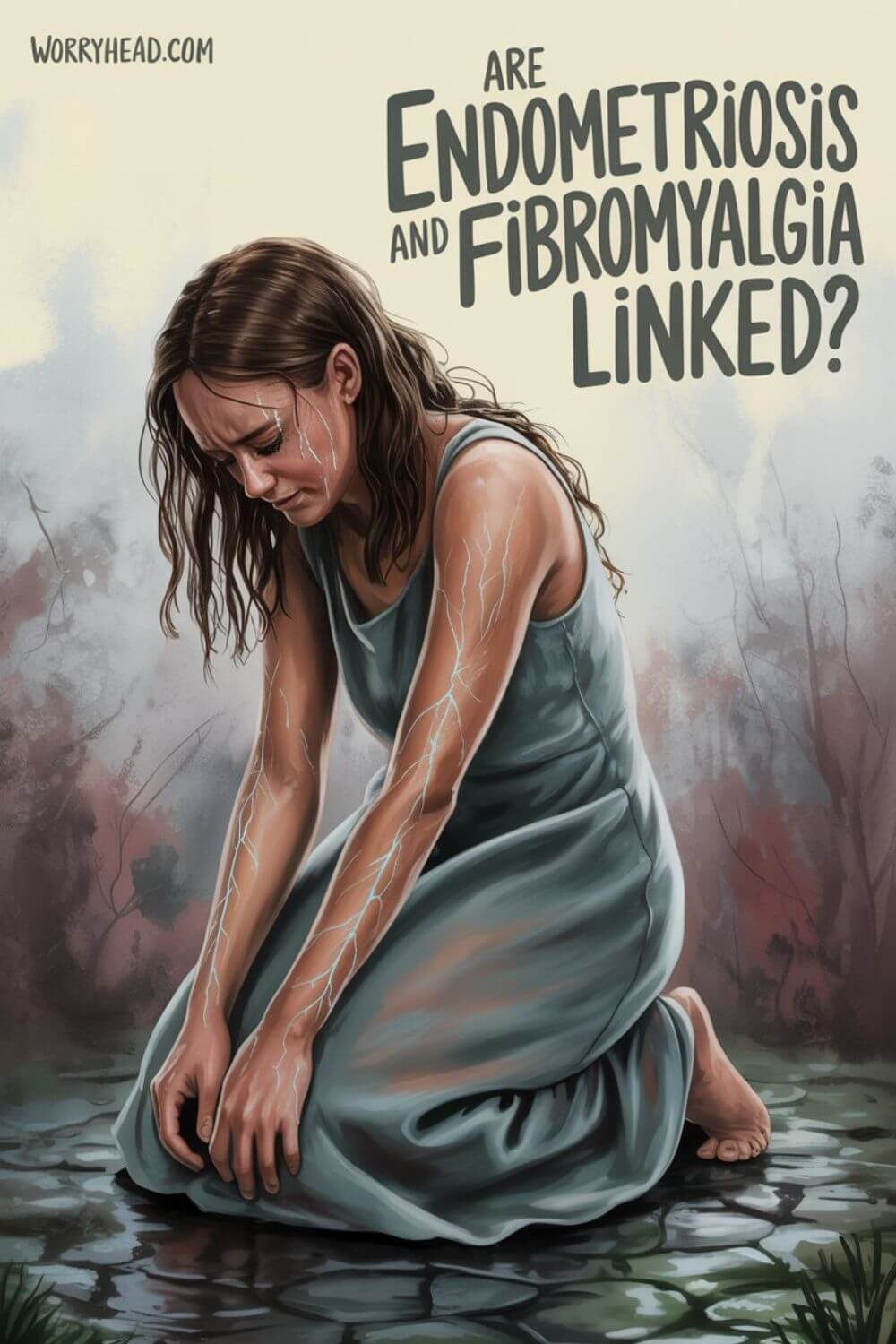Are Endometriosis and Fibromyalgia Linked?
Have you ever wondered are endometriosis and fibromyalgia linked, and if so, what that truly means for the woman you love? Have you felt helpless watching her navigate symptoms you can’t see but can clearly feel in the weight they bring to her life and yours?
Yes, these two chronic illnesses can be deeply intertwined, sharing biological pathways that make symptoms more complex and life more challenging, not just for her, but for both of you as a couple.
I’ve seen this link unfold in my own home. My wife battles both conditions, and I’ve learned it’s not just about understanding the pain, it’s about understanding why that pain happens, and how one condition can magnify the other. When you love someone through this, you start to see patterns others miss: flares that seem connected, fatigue that deepens, emotions that swing when symptoms collide.
Keep reading, because what I’m about to share might change how you see her pain and how you can stand beside her in ways that truly matter.
- So Are Endometriosis and Fibromyalgia Linked?
- Nervous System Link Between Endo and Fibro
- Why Pain Pathways Overlap in Both Conditions?
- How Stress Intensifies Endo and Fibro Symptoms?
- Hormonal Impact on the Endo–Fibro Connection
- Partner Tips for Supporting Dual Flare-Ups
- Helping Her Through Multiple Diagnostic Tests
- Why Is the Endo–Fibro Link Under-Researched?
- Immune Dysfunction’s Role In the Endo–Fibro Link
- How Sleep Quality Affects Endo and Fibro?
- Keeping a Joint Health Journal As Partners
- Conclusion on Are Endometriosis and Fibromyalgia Linked
So Are Endometriosis and Fibromyalgia Linked?
When I first began to ask myself are endometriosis and fibromyalgia linked, I wasn’t looking for a textbook answer, but I was searching for a way to understand what my wife was going through.
I’d watch her wake up with pain in her lower abdomen, and by the afternoon, her whole body would ache as if every muscle had been through a battle. It wasn’t just random.
There was a rhythm to it, an invisible thread connecting two conditions that doctors often treated as separate.
Over time, I began to notice that her endometriosis flares weren’t always isolated. They could trigger a cascade of fibromyalgia symptoms like fatigue that made even sitting upright exhausting, or a kind of whole-body ache that seemed to hum beneath her skin.
Some days, her pain didn’t respect neat medical categories. It blended, it overlapped, it became something bigger than either diagnosis alone.
As a partner, this was a hard truth to swallow.
You want to believe that if you can just figure out the pattern, you can somehow help break it. But what I learned is that these conditions don’t just share physical symptoms; they can also interact through the nervous system, hormones, and the body’s stress response. One bad flare in one condition can fan the flames of the other.
That’s why my role has never been just about helping her through “endo days” or “fibro days.” It’s about being present for the in-between days, the ones where pain is quieter but still there, shaping how she moves, eats, sleeps, and feels. It’s about accepting that some questions don’t have simple answers, but that my support, my attention, and my willingness to learn can still make a difference.
Even though the medical world is still piecing together how and why these two illnesses are connected, living alongside her has shown me the truth in ways research papers can’t. The link isn’t just clinical, it’s lived, every single day. And that’s why for blokes like us, understanding matters so much!

Nervous System Link Between Endo and Fibro
When I first began to understand the nervous system endo fibro link, it was like a missing puzzle piece falling into place.
My wife’s pain wasn’t just coming from “two separate illnesses” but from a nervous system that was on constant high alert. Her body had been rewired by years of chronic pain, so even the smallest trigger could send her into another flare.
I remember nights when she’d wake up from a deep sleep, clutching her stomach, but within an hour, her whole body ached as if she had the flu. That’s when I realised – her nervous system wasn’t distinguishing between endometriosis pain and fibromyalgia pain. It was amplifying both. The signals got tangled, and the result was unbearable.
This connection isn’t something most doctors explain in a 15-minute appointment. You have to live it to really see it. Her body had become a battlefield of constant messages firing through nerve pathways, making recovery slower and flare-ups more unpredictable.
I’ve learned that reducing overall stress on her nervous system, whether through gentle touch, quiet evenings, or simply being present, can sometimes be the difference between a manageable day and a crisis.
As a partner, you start to realise you’re not just fighting pain, you’re fighting the overactive alarm system inside her. That means patience, understanding, and calm become as important as any medication.
Why Pain Pathways Overlap in Both Conditions?
I used to think pain was pain, that it stayed in one place. But the more I learned about pain pathways of endo and fibro, the more I understood why her pain could start in her pelvis and spread through her entire body. Chronic illnesses like these can change the way her brain and spinal cord process pain, making them hypersensitive over time.
There were days when even a gentle hug would make her flinch, not because I hurt her, but because her body interpreted even mild pressure as a threat. That’s central sensitisation – a state where the volume on her pain receptors is turned up so high that there’s no turning it down.
Endometriosis and fibromyalgia can feed into this process, each making the other more intense.
Living with her has taught me that managing this isn’t about “fixing” the pain, because you can’t just switch it off.
It’s about protecting her from unnecessary triggers, pacing activities, and understanding when to step in and when to simply let her rest. It’s about recognising that some days, her body is processing pain in a way most people will never understand, and meeting that reality with compassion instead of frustration.
Next, I’ll share how stress and hormonal shifts can make this link even more powerful, and what that means for you as her partner.

How Stress Intensifies Endo and Fibro Symptoms?
When I began to see the connection between stress, endo-fibro symptoms, it changed how I approached daily life with my wife. Stress wasn’t just an emotional weight; it was a physical trigger. Even small stressors, like a noisy environment or a last-minute change in plans, could set her body into overdrive, making her pain worse and her energy crash.
I’ve watched it happen countless times. A tense conversation, a worrying phone call, or even the pressure of knowing she has commitments the next day could lead to a flare. It’s as if her body takes emotional strain and converts it directly into physical pain. The muscles tighten, inflammation rises, and suddenly we’re dealing with a flare-up that might last days.
This isn’t about avoiding all stress; it’s about managing it in a way that protects her health. We’ve built little rituals into our lives with slow mornings without rushing, breathing exercises before bed, and making sure she feels safe to say no without guilt. It is because when stress levels drop, her symptoms are less intense, and her recovery is faster.
For me, it means being the calm in her storm. I can’t remove every challenge, but I can make our home a place where her body doesn’t have to fight both the illness and the chaos of the world at the same time.
Hormonal Impact on the Endo–Fibro Connection
The hormonal endo fibro connection is something I didn’t fully understand until I started tracking her symptoms alongside her cycle. Endometriosis is deeply tied to hormonal changes, but I hadn’t realised how those same shifts could influence her fibromyalgia symptoms.
In the week before her period, her endo pain would spike, but so would her fibro pain. She’d feel heavier, achier, and more fatigued, almost as if her body was carrying extra weight. Hormonal fluctuations seemed to amplify nerve sensitivity, making her more vulnerable to widespread pain.
This meant that some weeks of the month were harder than others, and planning around that became part of our lives. I learned not to schedule big commitments for her during those times, and instead, we’d focus on rest, nourishing foods, and low-stress activities. Understanding her hormonal patterns allowed me to anticipate her needs instead of reacting too late.
As her partner, respecting these rhythms isn’t about limiting her; it’s about helping her live more fully by working with her body instead of against it. Hormones might not be something I can control, but the environment I create for her during these vulnerable times can make all the difference.
Next, I’ll share my most valuable partner strategies for helping during dual flare-ups and how to support her through the exhausting process of multiple diagnostic tests.

Partner Tips for Supporting Dual Flare-Ups
When both conditions flare at the same time, it can feel like the world has shrunk to the size of our bedroom. Partner support dual flare is about more than offering a cup of tea or reminding her to take medication. It’s about understanding that her body is fighting two battles at once, and that fight drains her on every level.
During these times, I step into a quiet, steady role.
I take over small but important tasks: preparing easy-to-digest meals, keeping the room dim and calm, handling phone calls or errands so she doesn’t have to. It’s not about doing everything for her, but it’s about removing the noise and stress that make recovery harder.
I’ve learned to listen closely to what she needs without assuming I know best. Sometimes she wants to talk and be distracted; other times, she needs complete silence. Checking in gently rather than hovering gives her the space to rest without feeling smothered.
And most importantly, I remind her – without empty platitudes – that this will pass. I anchor her to the reality that she’s survived every flare before and will survive this one too, with me beside her every step.
Helping Her Through Multiple Diagnostic Tests
Endo fibro diagnostic testing can feel like a marathon with no finish line. The appointments, the invasive procedures, the endless forms, it’s exhausting before the tests even begin. My wife has been through countless scans, blood draws, and specialist consultations, and each one takes a toll not just physically, but emotionally.
I’ve made it my job to be her constant through it all. I sit beside her in waiting rooms, not on my phone but fully present. I ask the questions she might forget to ask, and I take notes so she doesn’t have to hold every detail in her already overloaded mind.
Testing days are draining, so I plan ahead, bringing her a favourite snack, a warm scarf for cold hospital rooms, or making sure we come home to a tidy, calm space. These small comforts help her feel cared for when she’s at her most vulnerable.
And when results come in, whether they bring clarity or more uncertainty, I’m there to process them with her. The truth is, sometimes the hardest part isn’t the test itself, but the waiting in between. That’s when my role matters most: keeping her grounded, hopeful, and never alone in the unknown.
Next, I’ll explain why the link between these conditions is still so under-researched and how immune system dysfunction might play a bigger role than most people realise.

Why Is the Endo–Fibro Link Under-Researched?
The fact that the endo fibro under-researched link still exists is something that frustrates me deeply. Living with my wife’s illnesses, I’ve seen firsthand how connected they are, yet the medical literature treats them as distant cousins rather than close relatives. The lack of funding, combined with the fact that both conditions primarily affect women, means research often falls through the cracks.
Too many doctors work in silos, gynaecologists focusing on endometriosis, rheumatologists on fibromyalgia, without a central bridge of knowledge between them. This fragmentation leaves women like my wife bouncing between specialists, each treating a piece of the puzzle but rarely putting it all together.
The result? Delayed diagnoses, trial-and-error treatments, and years of unnecessary suffering. If more research connected the dots between these conditions, we could have better diagnostic tools, more targeted therapies, and, most importantly, fewer women feeling dismissed or misunderstood.
As a partner, it’s maddening to watch her live with symptoms that science could explain better if only it looked harder. Until that changes, I see my role as both supporter and advocate, keeping records, asking tough questions, and reminding her that her experience is valid, even if the medical system hasn’t caught up yet.
Immune Dysfunction’s Role In the Endo–Fibro Link
When I learned about immune dysfunction endo fibro, it was like discovering a hidden engine driving so much of her pain. Both conditions are linked to immune system irregularities—her body reacts to inflammation differently, sometimes going into overdrive, sometimes failing to regulate it at all.
It’s not just about pelvic pain or muscle aches; it’s about a body that’s constantly on alert, misfiring signals, and attacking itself in subtle but relentless ways. This underlying immune dysfunction could explain why flare-ups seem to come from nowhere, or why recovery takes so long.
In our daily life, this knowledge shapes how we approach her health. We focus on reducing inflammation through diet, rest, and stress management. We’ve also learned to spot early warning signs such as a sudden wave of fatigue, unexplained swelling, or heightened sensitivity, that might signal her immune system is gearing up for another battle.
The science might not have all the answers yet, but knowing the immune system plays a role has helped me see her illnesses as more than separate conditions. They are two sides of the same war, and my job is to help her protect her strength for the fights that matter most.
Next, I’ll share how sleep quality can drastically influence these conditions and why keeping a joint health journal together can transform the way you both navigate her health.

How Sleep Quality Affects Endo and Fibro?
When I started connecting the dots between sleep quality and endo-fibro, I realised poor rest wasn’t just a side effect, it was a driving force in how severe her symptoms became. My wife’s body needs deep, restorative sleep to heal, but pain often keeps her from reaching it. Even on nights when she sleeps for hours, she can wake up feeling as if she hasn’t rested at all.
I’ve noticed that during flare-ups, her sleep is lighter and more fragmented. She’ll wake multiple times in the night, sometimes from sharp pelvic pain, other times from the deep, dull ache of fibromyalgia. Without enough deep sleep, her nervous system stays on high alert, making her more sensitive to pain the next day.
We’ve had to treat sleep like medicine – creating a dark, cool, quiet environment, using gentle bedtime routines, and protecting her sleep schedule as if it were an important appointment. It’s not always perfect, but when she gets even one night of truly restful sleep, her mood, energy, and pain tolerance improve noticeably.
As a partner, I’ve learned that supporting her sleep is one of the most powerful ways I can support her overall health. It’s not glamorous, but it’s life-changing.
Keeping a Joint Health Journal As Partners
Starting a joint health journal partners project with her has been one of the most practical and surprisingly emotional things we’ve done together. At first, it was just a way to track symptoms, medications, and triggers. But over time, it became a shared space where we could see patterns we’d otherwise miss.
We record when her endometriosis pain spikes, when fibromyalgia symptoms flare, what she’s eaten, how well she’s slept, and even her stress levels. Over weeks and months, it’s helped us spot trends, like certain foods making symptoms worse, or stressful weeks leading to more intense flares.
The journal has also deepened our communication. Instead of guessing what might be going on, we can look together at the facts. It’s taken away some of the helplessness I used to feel, replacing it with a sense of teamwork.
And there’s an unexpected benefit: flipping back through the pages shows us progress we might not notice day-to-day. Yes, there are bad weeks, but there are also stretches where symptoms are lighter, and those small victories keep us going.
Next, I’ll bring everything together in a conclusion, summarising what I’ve learned about the link between endometriosis and fibromyalgia, and what it means for partners who want to truly support the woman they love.

Conclusion on Are Endometriosis and Fibromyalgia Linked
After years of living alongside my wife’s endometriosis and fibromyalgia, I no longer see them as two separate battles.
The answer to are endometriosis and fibromyalgia linked is yes – sometimes subtly, sometimes unmistakably. I’ve seen how her nervous system, pain pathways, hormones, immune system, and even her sleep form an intricate web where one tug can set the whole structure shaking.
This link isn’t just a medical curiosity; it’s a lived reality. When her endometriosis flares, fibromyalgia symptoms often surge right behind it. When fibromyalgia drains her energy, her endometriosis pain becomes harder to bear. It’s a feedback loop that makes each condition harder to manage.
And while research still lags far behind the experiences of people like my wife, those of us living this every day don’t need more proof to believe it’s real.
For partners, the challenge is learning to read the signs before a flare becomes a storm. It means paying attention not just to the obvious symptoms, but to the stress levels, the hormonal cycles, the quality of her sleep, and the subtle shifts in her mood or posture that hint at what’s coming.
Supporting her through this connection isn’t about trying to fix it. It’s about softening the world around her so her body doesn’t have to fight quite so hard. It’s about creating calm when her nervous system is overloaded, offering rest when her muscles and joints ache, and standing beside her without judgment when her emotions dip under the weight of constant pain.
I’ve learned to treat her health as a partnership, not a project. Tracking symptoms together, building routines that protect her sleep, and finding ways to lower stress all of these matter just as much as medical treatments. And the truth is, my role isn’t passive. I’m not just watching her fight, I’m helping hold the line.
If there’s one thing I want other men to take away from our story, it’s this: your presence matters more than you think. She may be the one in pain, but the way you respond – patiently, consistently, without resentment – can be the difference between her feeling alone in her illness and feeling deeply supported.
These illnesses may be linked in the way they attack her body, but you can be the link that strengthens her, that reminds her she is more than her symptoms. And while you can’t take away her pain, you can make sure she never has to carry it alone.
When partners step up, not to rescue, but to walk beside, it changes everything!
I’d love to hear your thoughts on this—leave a comment and share your experience, and don’t forget to check out the FREE chapter of my eBook.


About Me
Hi, I’m Lucjan! The reason why I decided to create this blog was my beautiful wife, who experienced a lot of pain in life, but also the lack of information about endometriosis and fibromyalgia for men…
READ MORE